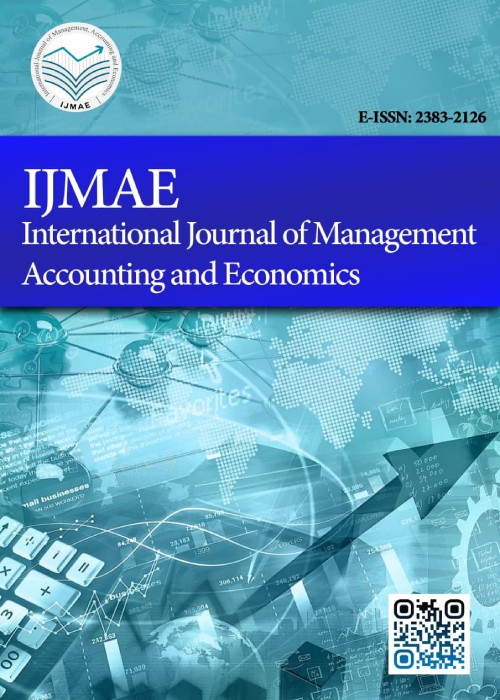فهرست مطالب
International Journal of Management, Accounting and Economics
Volume:1 Issue: 3, Oct2014
- تاریخ انتشار: 1393/07/28
- تعداد عناوین: 4
-
Page 186The importance and role of reverse supply chain in gaining competitive advantage has been recognized especially in recent years. However the high costs of implementing and installing these chains works as an impediment for managers. Collaboration as a key to success in supply chains can be a way todecrease the costs and make reverse supply chains economically attractive. This paper proposes a conceptual model for collaboration between reverse supply chains in accordance with VMI in forward supply chains. Firstly aconceptual model is defined by introducing members and assumptions needed for that. Then a collaborative process for collection and routing between members of these chains and a heuristic method using modified tabu search for finding the best routs are defined. Finally an example is solved for some separate reverse supply chains once in the case of isolated chains and then for the collaboration between them in the suggested form of this paper.Keywords: Collaboration, Vendor Managed Inventory (VMI), Reverse Supply Chain
-
Page 201In this paper, the Iran Business Cycle characteristics were investigated via numerous univariate and multivariate Markov-switching specifications. In this case Markov switching model MSM-ARMA is proposed for determining business cycles. We examined the stochastic properties of the cyclical pattern of the quarterly Iran real GDP between 1988 (1) – 2008 (2). The empirical analysis consists of mainly three parts. First, a large number of alternative specifications were tried and few were adopted with respect to various diagnostic statistics. Then, all selected models were tested against their linear benchmarks. LR test results imply strong evidence in favor of the nonlinear regime switching behavior. In line with the main objective of research, proposed model for Iran business cycle is estimated by and result of this estimation showed that economic of Iran despite of having two periods of recession 1992(3) - 1992(4) and 1995(1)-1995(2), is out of recession with moderate growth and also experienced growth with high rate in early period of studying. Also the possibility of resistance of recession regimes with moderate and high growth is 0.3, 0.92 and 0.5 respectively. The results show the economic tend to stay in moderate growth regime.Keywords: Markov Switching Models, Business Cycles, MS, ARMA, Iran Economy
-
Page 215The main purpose of this article is to check the growth and trend of Islamic banking and finance in the world of finance. It shows the globalization of Islamic banking through total assets of Islamic banks of different countries of the Middle East and South Asia. The findings hold that Islamic banking is becoming more popular and making so many improvements day by day as compare to conventional banking system throughout the world. The growing hubs of Islamic Banks provide the base line and launching pad for the promotion of Islamic banking and finance in the world market. Especially, the increase in oil prices in the Middle East Countries made the economy strong and prolong boom in the market and this factor is the cause of successful Islamic Banking in the Middle East Countries. The total assets of top class Islamic Banks of Middle East Countries (Bahrain, Iran, Jordan, Kuwait, and Lebanon) and South Asian Countries (Pakistan, Bangladesh) shows the growth and advancements of Islamic banking within the globe. This article focuses on the globalization of Islamic banking by showing the total assets in (USD million) of Islamic banks of Middle East and South Asia. For this purpose the annual reports of the perspective Islamic Banks have been taken and total assets have been showed by converting different currencies into one currency in USD million. It reflects that how the Muslim governments and Muslim community are enjoying the Islamic banking (Interest free Banking) and finance and Islamic banking is promoting day by day throughout the world.Keywords: Islamic Banking, Growth, Development, Iran, Pakistan
-
Page 229Studies conducted by many researchers indicate high failure rate of projects of implementing ERP systems. Furthermore, organizations should be agile to be able to respond to market changes fast and effectively to survive in competitive environment. ERP and agility are two important tools for achieving competitive advantages. The main goal of the present study was to identify and prioritize organizational readiness factors for implementing ERP based on organizational agility. In this study, along with extension of McKinsey 7S model (strategy, structure, systems, skills, style, staff, shared values) to 9S (7S+ self-evaluation and supportive factors) model, agilitycriteria were weighted and rated using group AHP with fuzzy logic approach; so that accountability, speed and flexibility have obtained the maximum score. The nine organizational readiness factors were ranked using integrated FAHP and TOPSIS method based on five criteria of agility. The framework was proposed to a real case of Shiraz distribution cooperative firms. Results showedthat among the nine organizational dimensions based on agility, the two addedto McKinsey dimensions (self-evaluation and supportive factors) are ranked in the first and fourth places. The proposed framework help the enterprises “to implement ERP system with agility approach” concentrate on change management and develop strategies based on their own priority.Keywords: Organizational readiness, ERP, organizational agility, McKinsey model


